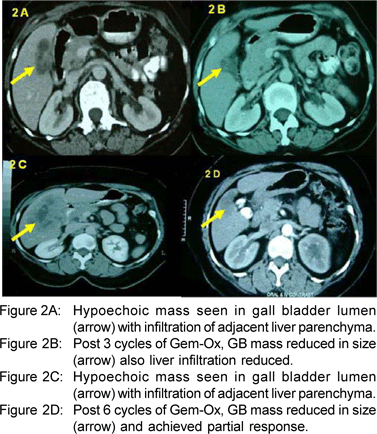Atul Sharma, Amit Dutt Dwary, Vaithiswaran V, Sujoy Pal, S. Dutta Gupta, N.K. Shukla, Vinod Raina, S. Thulkar, Bidhu K Mohanti
Associate Professor of Medical Oncology
Dr BRA IRCH, AIIMS
New Delhi 11 00 29, India
Corresponding Author:
Dr Atul Sharma
Email: atul1@hotmail.com
48uep6bbphidvals|318 48uep6bbph|2000F98CTab_Articles|Fulltext Gemcitabine and Oxaliplatin as single agents or in combinations with others have shown some activity in adenocarcinoma of pancreas, gall bladder, and biliary tracts.[2,3,4] Gemcitabine is among several new anticancer drugs under investigation in the treatment of biliary tract cancer. Objective responses of up to 36% have been reported in different series.[2,3,4] We hereby describe two cases of unresectable gall bladder cancer that not only were operated upon after Gemcitabine and Oxaliplatin (GEMOX) chemotherapy but also achieved complete pathological response.
Case reports
Case 1
A 50 years old lady presented in August 2004 with 3 months history of biliary colic and weight loss. Investigations were suggestive of cholelithiasis and gall bladder mass. Exploratory laparotomy was done in August 2004 but because of extensive disease (gall bladder mass with multiple lymph nodes at cystic duct and junction of CBD and liver infiltration), resection could not be done. However, biopsy tissue was obtained which confirmed the diagnosis of poorly differentiated adenocarcinoma (Figure 1A).
CT scan revealed the gall bladder mass, liver infiltration (segment IVB and V) and lymph nodes along CBD and portal vein (Figure 2A). She was planned for palliative chemotherapy with GEMOX. Doses were - Gemcitabine 900mg/m2 and Oxaliplatin 80 mg/m2, both IV infusion on day 1 and 8 and to be repeated every 3 weeks. Repeat CT scan done after 3 cycles revealed significant reduction in size of gall bladder mass and lymph nodes and disappearance of liver lesions (Figure 2B). At this time, she was considered operable and underwent radical cholecystectomy in January 2005. The detailed pathological examination of specimen did not reveal any tumor cell and was labeled as complete pathological response (Figure 1B). Patient completed total of 6 cycles of chemotherapy and is on regular follow up. She was recently seen in March 2008 with a fresh CT scan which did not show any abnormality.

Case 2
A 38 years old female, presented to us with abdominal pain since one month. Clinical examination revealed right upper quadrant lump 6cm in size, below costal margin in midclavicular line. Contrast enhanced computed tomography (CECT) of abdomen showed gall bladder mass infiltrating into duodenum and liver with retroperitoneal (RP) nodes (Figure 2C). Ultrasonography guided aspirate from GB mass showed adenocarcinoma. Further evaluation revealed no other site of metastasis. She was considered inoperable by surgical oncologists at our institute. She was then started on palliative chemotherapy with GEMOX protocol. Post 3 cycles, CECT revealed > 50% reduction in the size of GB mass and disappearance of RP lymph nodes suggesting partial remission. She was then given 3 more cycles of chemotherapy. CECT post 6 cycles showed 60-70% reduction in size of GB mass with infiltration of segment 4 and 5 of liver (Figure 2D). Patient was reassessed for surgery and found operable. Radical cholecystectomy was done in January 2007. Extensive histopathological examination of surgical specimen did not show any evidence of tumor in resected specimen and she was labeled having achieved pathological CR. Patient is on regular follow up and current CT scan in April 2008 did not show any abnormality.

Discussion
GBC is the most common biliary malignancy. Unfortunately, most of the cases present in advanced and unresectable stage and are candidates for palliative treatment only. Currently there is no standard therapy for GBC and it is not considered chemosensitive disease. Median survival for patients presenting with unresectable disease is 2-4 months, with 1 year survival < 5%.[6] There is no standard therapy for these patients. Gemcitabine as a single agent has shown response rates of 18% and median survival of 8.8 months.[1] Doval et al,[3] in a study using gemcitabine and DDP have reported 38% response rates and 4.8 months of median survival. Most of the responses reported with chemotherapy are radiological PR and some CR.[3] To our knowledge, the report described here is the first report in English literature where pathological complete response to chemotherapy for unresectable gall bladder cancer has been reported. This report in our opinion is very encouraging and should encourage clinicians treating this disease.
References
1. Okusaka T, Ishii H, Funakoshi A, Yamao K, Yamao K, Ohkawa S, Saito S, et al. Phase II study of single-agent gemcitabine in patients with advanced biliary tract cancer. Cancer Chemother Pharmacol. 2006;57:647–53.
2. Hsu C, Shen YC, Yang CH, Lu YS, Lu YS, Hsu CH, et al. Weekly gemcitabine plus 24-h infusion of high dose 5- fluourouracil/leucovorin for locally advanced or metastatic carcinoma of biliary tract. Br J cancer. 2004;90:1715–9.
3. Doval DC, Shekhon JS, Gupta SK, Fuloria J, Shukla VK, Gupta S, et al. A phase II study of gemcitabine and cisplatin in chemotherapy-naive, unresectable gall bladder cancer. Br J cancer. 2004;90:1516–20.
4. Andre T, Tournigand C, Rosmorduc O, Provent S, Maindrault- Goebel F, Avenin D, et al. Gemcitabine combined with oxaliplatin (GEMOX) in advanced biliary tract adenocarcinoma: a GERCOR study. Ann Oncol. 2004;15:1339–43.
5. Cancer Incidence and Mortality in Delhi UT Urban- 2002- 2003. Publication of Dr BRA IRCH All India Institute of Medical Sciences. March 2007
6. Takada T, Nimura Y, Katoh H, Nagakawa T, Nakayama T, Matsushiro T, et al. Prospective randomized trial of 5- flourouracil, doxorubicin, and mitomycin C for nonrespectable pancreatic and biliary carcinoma: multicenter randomized trial. Hepatogastroenterology. 1998;45:2020–6.
|